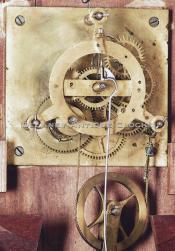Silas Burnham Terry Wall Regulator. Terryville, Connecticut, circa 1840. UU-34.
This very early wall regulator was made by Silas B. Terry of Terryville, Connecticut. This clock was made circa 1840 and shared the form that Arron Willard, J. N. Dunning, and Abel Stowell were making in Boston some 15 years earlier. However, Terry's version differs from theirs in that the dial is not concaved, and the case is approximately four inches longer.
I believe that this form was originally designed for commercial applications. It may be one of the earliest clock forms built for that purpose in America. We have found similar clocks in limited numbers over the years, signed by the clockmakers Aaron Willard, Abel Stowell, and J. N. Dunning. In fact, I was fortunate to appraise an Aaron Willard example on the Antique Roadshow in 2007. Unfortunately, this early commercial form did not survive well due to the lack of a personal connection due to being owned and/or displayed by a business establishment of some kind. We know the form was popular because others extensively copied and slightly modified the form over the years. These clockmakers that made similar models that sold well were E. Howard, Seth Thomas, Boston Clock, etc.
This fine example is constructed in mahogany having New England white pine as a secondary wood. The mahogany veneers positioned on the front surfaces of the case are richly grained. The top of the case is fitted with a turned wood bezel. The iron dial is protected by glass. This dial measures 11 inches in diameter and features Roman hour numeral figures inside a closed minute ring. The lower door is trimmed with a cock-beaded molding. The construction of the back of this door is unusual in that it is framed. Through this door, one can access the brass-faced pendulum bob for regulation and cast lead weight. One can also view the Maker's label, which is pasted to the weight board.
The brass-constructed movement is unusual. The backplate is a square that is attached to the backboard with four screws. The front plate is a circular form and is skeletonized. This is secured to the back plate with three taps that are pinned to posts extending from the backplate. The brass gearing is located between these plates. This movement winds at 7:30. It is weight powered and designed to run eight days on a full wind.
This clock was made circa 1840. It is 34.25 inches long, 13.75 inches wide at the bezel, and less than 4 inches deep.
Inventory number UU-34.
Silas B. Terry was born on February 1, 1807 (during Eli's involvement with the porter contract) and died of a heart attack on May 20, 1876. He was the youngest of eight children born to Eli & Eunice (Warner) Terry. Silas worked in various clockmaking enterprises. Unlike his father, he focused on the more expensive brass-geared clocks and was in the process of producing them as early as December of 1833. He was an inventive person and was constantly testing new designs. One of the most notable was the application of the balance wheel to clock movements. Silas was granted a patent for this on August 9, 1845. Silas was involved with several clockmaking firms, which included the S. B. Terry & Company (1852-1853) and Terryville MFG., Co. (1853-1854). In 1854, Terry went bankrupt and took a job as a general manager of the William L. Gilbert & Company of Winsted, Connecticut. In 1861, he took a job as superintendent of the Waterbury Clock Company. In 1867, he formed the Terry Clock Company in Waterbury with his sons. Silas' early clocks were well made and often had interesting movements. The evidence of his work supports the suggestion that he loved to tinker.








